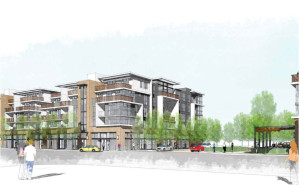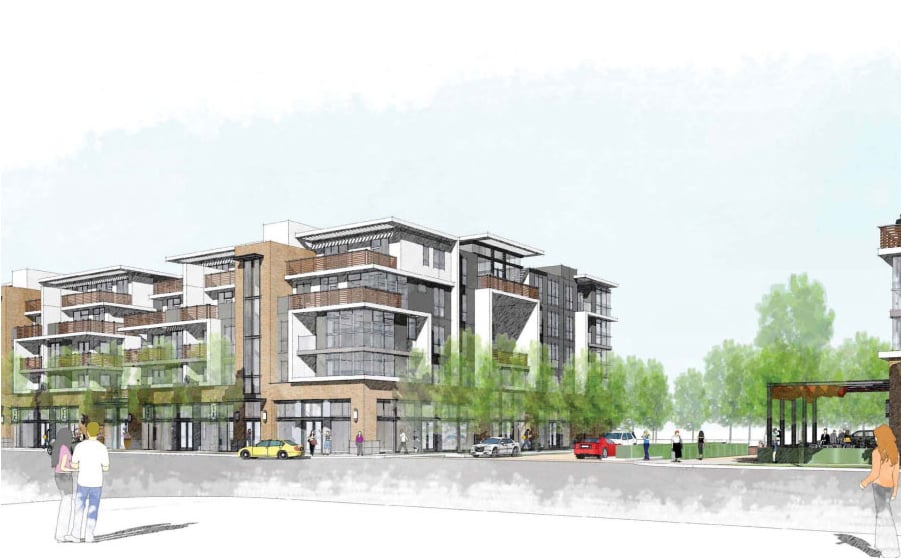Despite the University’s decision to modify its proposal for a mixed-use development project at 500 El Camino Real, many Menlo Park citizens remain unsatisfied with Stanford’s plan and have continued to publicly protest the project.
University administrators and local government officials continue to differ, meanwhile, on whether further revisions will take place before the project moves forward.
The revised proposal, which was released in April, featured several significant changes to the previous development plan, including the reduction of medical office space from 96,000 square feet to 27,000 square feet, the addition of 22 apartment units and revisions to the design of a public plaza.
Though these modifications addressed some of the citizens’ concerns, including the potential influx of traffic and a worsened housing deficit, Menlo Park resident Perla Ni, the spokesperson for a grassroots group called Save Menlo Park, said that the alterations were not drastic enough.
“No one was happy with those changes,” Ni said. “So many people believed that the revision was wholly inadequate to address the needs in the community.”
The revisions were presented at an April 16 Menlo Park City Council meeting that lasted until 2 a.m. At the meeting, the City Council formed a subcommittee composed of two members, Kirsten Keith and Catherine Carlton, to further explore the proposal.
Keith said one of the subcommittee’s primary responsibilities will be communicating with the many parties who have a stake in the issue.
“What I’m interested in doing is working with Stanford and our neighborhood groups to come up with something that will be a benefit for our community and for Stanford,” Keith said. “People don’t want to see vacant lots on El Camino Real. They want to see something done with those lots that is a benefit to Menlo Park.”
Citizens’ expectations still unfulfilled
While Keith said that she saw several significant improvements in Stanford’s most recent proposal, particularly with respect to the public plaza, Planning Commission Chair John Kadvany said that he, like Ni, had expected more revisions.
“Everybody was expecting something pretty significant there, and what Stanford has proposed is sort of a pitiful excuse for a public plaza,” Kadvany said. “In terms of public social space, it is just pathetic. That’s strong language, but vibrant public spaces and street life is what Menlo Park wants.”
According to Kadvany, citizens’ expectations were also not met with regards to the quantity of housing units and the installation of a hotel and senior living complex, which had been discussed at several informal meetings.
Kadvany noted that citizens were also disappointed with the fact that it would be difficult to integrate a bike and pedestrian tunnel into the current design.
“There is no expression here of any interest in contemporary design and planning issues. It’s really kind of appalling for a world-class university,” he said. “Really all they care about are the leases they get from the office space and the rents from the housing. This was designed by a spreadsheet in which the bottom line is what revenue this provides for Stanford.”
Kadvany’s sentiments were echoed by City Council member Rich Cline, who said that he was surprised by many components of the proposal at a City Council meeting in early April. Ni agreed that the University had “misrepresented its development intentions” to the City Council.
“The original representation they had made for the city was that this project would be for the desperately-needed housing in this area,” Ni said. “After receiving enormous concessions that are worth hundreds of million of dollars in development rights, they decided to change their use to office [space], which is nothing. Nobody needs more offices in this area. We need more housing.”
Compliance with the Specific Plan
Stanford’s proposal complies with the stipulations of the Specific Plan, a “framework for private and public improvements” to Menlo Park over the next few decades, according to the plan’s summary.
However, Kadvany said that compared to previous development projects, the plan allows Stanford far too much leeway, as there is no framework for a negotiation process if the proposal meets the plan’s criteria.
“We just gave the criteria with basically no control,” Kadvany said. “There is something called architectural control, which means the Planning Commission can critique the buildings in terms of aesthetics, but not a whole lot else. On the whole, all we have is this aesthetic dimension.”
Though Kadvany voted in favor of the Specific Plan, which was approved by the City Council in June 2012, he now argues that the process should have been designed to “give us a lot more control,” perhaps by creating additional review opportunities for large projects like Stanford’s proposal.
“We could have built in safeguards against the incredible leverage that Stanford now has in this project,” he said. “The basic parameters are fine, but the city has to have more control. You can’t give away all your negotiating power — it’s totally irresponsible. The idea that the City Council can live with this raises eyebrows, to say the least.”
While Kadvany suggested potentially revising the Specific Plan, Menlo Park resident Clem Molony, who said he went to “most of the meetings” during the four-year period over which the Specific Plan was formed, offered a more positive outlook on the process.
“Generally when a Specific Plan is done as carefully as ours was done, they thought about this and looked at the cumulative impact of all the development on traffic and figured out it is going to be okay,” Molony said.
Although Molony acknowledged the concerns of citizen groups like Save Menlo Park, particularly about traffic, he said he has faith that the City Council will “figure that out.”
“This proposal is being fine-tuned right now and the planning process is really robust,” he said. “The neighbors will find, once it’s built, that the impacts are not as terrible as all the exaggerators say. I am sure this is going to be a very beneficial project for Menlo Park.”
Obstacles to construction
As well as meeting with Stanford officials and community members, the City Council’s subcommittee will conduct a larger traffic study to analyze potential cut-through traffic impacts, which Keith said will take “many, many weeks.” The Specific Plan will also be reviewed by the City Council in June.
While Keith said that she expects more revisions to be made to the proposal, Managing Director of Development Steve Elliott emphasized that Stanford does not intend to make any more modifications based on citizen requests.
According to Elliott, Stanford officials have already met with representatives from Save Menlo Park, the Sierra Club, the Chamber of Commerce and bicycle advocates, as well as other Menlo Park citizens, and “have listened carefully to the community.”

“We’re not planning on making any more revisions. We are waiting for the city to do their work with their subcommittee and we are waiting to hear back on that,” Elliott said. “We still have to get architectural control approval for the project, we still have a ways to go to get approval, but we don’t have any plans at this time for an alternative project.”
However, Elliott noted that there are several more obstacles to be overcome before construction begins, including getting confirmation from the Planning Commission that the proposal is consistent with the Specific Plan, completing the traffic study, creating a housing agreement with the city and acquiring building permits.
“[The timeline is] pretty dependent on what the City Council and their subcommittee does and how quickly that moves along,” Elliott said. “There is a lot of uncertainty at this point so it is really hard to say when we might start construction, though we prefer to start it as soon as possible.”
